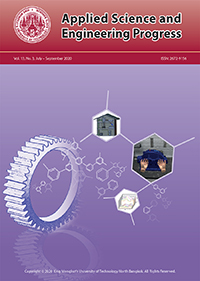Power Level Assignment and Base Station Placement Using Simulated Annealing for 4G-LTE Femtocell Networks in Multi-floor Buildings
Main Article Content
Abstract
Femtocell Base Stations (FBSs) are widely used to improve data rates and cell coverage to the indoor service in Long Term Evolution (LTE) networks. With a proper network's design, a network deployment cost will be worth and a network performance will satisfy the users. Nevertheless, with an improper design, besides all of the foregoing will not achieve, an unpleasant problem such as a leakage signal from an indoor to outdoor area will occur. In this paper, we propose an optimization technique which is a collaboration between a Linear Programming (LP) and a Simulated Annealing heuristic technique (SA). We separate our optimization technique into two steps. In step one, we focus on minimizing the number of FBS to be installed by formulating a linear programming problem. In step two, we optimize the placement location and the transmit power level of installed FBS by using the SA heuristic. Our results show that the proposed technique can achieve a better performance trade-off between computation time and solution quality. Besides, when compared to linear programming technique, the proposed technique can reduce the summation of leakage signal up to 90%, the total power usage up to 45% and reduce a computation time more than 70%.
Article Details
References
[2] Y. Li, H. Celebi, M. Daneshmand, C. Wang, and W. Zhao, “Energy-efficient femtocell networks: Challenges and opportunities,” IEEE Wireless Communications, vol. 20, no. 6, pp. 99–105, Dec. 2013.
[3] Y. L. Chung, “An efficient power-saving transmission mechanism in LTE macrocellfemtocell hybrid networks,” in Proceedings The International Conference on Information Networking 2014 (ICOIN2014), 2014, pp. 176–180.
[4] M. F. Khan and B. Wang, “Effective placement of femtocell base stations in commercial buildings,” in Proceedings 2014 Sixth International Conference on Ubiquitous and Future Networks (ICUFN), 2014, pp. 176–180.
[5] A. Ramamurthy, V. Sathya, V. Venkatesh, R. Ramji, and B. R. Tamma, “Energy-efficient femtocell placement in LTE networks,” in Proceedings 2015 IEEE International Conference on Electronics, Computing and Communication Technologies (CONECCT), 2015, pp. 1–6.
[6] V. Sathya, A. Ramamurthy, and B. R. Tamma, “Joint placement and power control of LTE Femto Base Stations in enterprise environments,” in Proceedings 2015 International Conference on Computing, Networking and Communications (ICNC), 2015, pp. 1029–1033.
[7] E. Yaacoub and Z. Dawy, “LTE BS placement optimization using simulated annealing in the presence of femtocells,” in Proceedings 20th European Wireless Conference European Wireless 2014, 2014, pp. 1–5.
[8] K. Han, Y. Choi, D. Kim, M. Na, S. Choi, and K. Han, “Optimization of femtocell network configuration under interference constraints,” in Proceedings 7th International Symposium on Modeling and Optimization in Mobile, Ad Hoc, and Wireless Networks, 2009, pp. 1–7.
[9] V. Sathya, A. Ramamurthy, and B. R. Tamma, “On placement and dynamic power control of femtocells in LTE HetNets,” in Proceedings 2014 IEEE Global Communications Conference, 2014, pp. 4394–4399.
[10] T. Kanungo, D. M. Mount, N. S. Netanyahu, C. D. Piatko, R. Silverman, and A. Y. Wu, “An efficient k-means clustering algorithm: Analysis and implementation,” IEEE Transactions on Pattern Analysis and Machine Intelligence, vol. 24, no. 7, pp. 881–892, Jul. 2002.
[11] F. S. Hillier, Introduction to Operations Research. New York: McGraw-Hill Education, 2012.
[12] Cisco, “Cisco Universal Small Cell 8738 Data Sheet,” Cisco, California, USA, 2015.
[13] S. P. Thiagarajah, A. Ting, D. Chieng, M. Y. Alias, and T. S. Wei, “User data rate enhancement using heterogeneous LTE-802.11n offloading in urban area,” in Proceedings 2013 IEEE Symposium on Wireless Technology & Applications (ISWTA), 2013, pp. 11–16.
[14] K.-L. Du and M. N. S. Swamy, Search and Optimization by Metaheuristics: Techniques and Algorithms Inspired by Nature. Switzerland: Birkhäuser, 2016.
[15] A. Srikae, Computational Intelligence. Nakhon Ratchasima, Thailand: Suranaree University of Technology, 2009.
[16] M. Wang, X. Zhu, Zh. Zeng, S. Wan, and W. Li, “System performance analysis of OFDMAbased femtocell networks,” in Proceedings IET International Conference on Communication Technology and Application (ICCTA 2011), 2011, pp. 405–410.
[17] C. S. Vardhan, D. V. Ratnam, N. Bhagyasree, and A. H. Dattu, “Analysis of path loss models of 4G femtocells,” in Proceedings 2014 Eleventh International Conference on Wireless and Optical Communications Networks (WOCN), 2014, pp. 1–6.
[18] N. R. Zulkefly, T. A. Rahman, A. M. Al-Samman, A. M. S. Mataria, and C. Y. Leow, “Indoor path loss model for 4G wireless network at 2.6 GHz,” in Proceedings 1st International Conference on Telematics and Future Generation Networks (TAFGEN), 2015, pp. 117–120.


